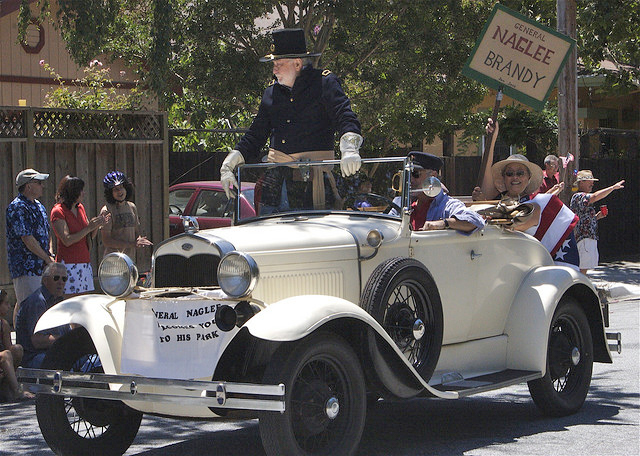Historian and Naglee Park Resident Jack Douglas as General Henry Morris Naglee
(Photo by Tom Clifton)
Henry Naglee
Henry Morris Naglee (1815-1886) was a native of Philadelphia and a graduate of the US Military Academy at West Point. Trained as a civil engineer, he came to California as an Army captain during the Mexican-American War (1846-1848) and stayed on as a civilian, developing a career in banking and real estate. Called back into military service during the Civil War, he served from 1861 to 1864, most notably in the Peninsula Campaigns. He was wounded during the Battle of Seven Pines. He married at age 50, after he returned to California from the War. His bride was 24, the socially prominent Marie Antoinette Ringgold, a descendent of President James Monroe. There were two daughters born of this marriage, Marie and Antoinette, named for their mother. Naglee’s wife died in 1869 at age 28.
Naglee Park was the name of the country home of Henry M. Naglee and his family. He first acquired the property in 1847 but was not able to begin development until 1858. Architect Victor Hoffman was the probable designer of the Gothic Revival style cottage designed for Naglee and his family. The house remains at the corner of 14th and San Fernando. The grounds were laid out as an English garden by landscape designer James R. Lowe. Avidly interested in experimental horticulture, Naglee installed a large vineyard and grew over a hundred varieties of grapes, searching for the perfect grape to make brandy. His brandy distillery and aging cellar were also located on the property. In addition to his San Jose country estate, Naglee maintained a San Francisco pied-a-terre at the Occidental Hotel, a house in Philadelphia and a 35,500 acre rancho near Stockton. In San Joaquin County, Naglee is credited with helping to reclaim the Delta by building miles of levees and converting his rancho land to productive use.
Naglee was involved in two sensational proceedings with young women during his life, and these two incidents overshadow a lifetime of service. The first event involved San Francisco actress Mary Schell, a young lady with whom Naglee corresponded during the Civil War. When his engagement to Miss Ringgold was announced, the spurned actress tried to blackmail Naglee, threatening to print some of his more passionate letters to her. Naglee refused to pay and so Miss Schell published, much to the amusement of readers for more than a century.
The second incident was similar but more serious. A widower with two young daughters, Naglee hired a local woman to serve as a companion for the two girls, then ages 6 and 2. Miss Emily Hanks grew up on 10th Street and hoped the wealthy and aging Naglee would marry her. Although her mother warned her against taking a position in the Naglee household, Miss Emily had other plans and worked at the Naglee estate for four years. When Emily became pregnant, she insisted the General was the father. Naglee refused to marry her, so she filed a “breach of promise” suit and won a settlement of $27,500 from a sympathetic local jury. The award was later overturned on appeal.
Naglee died in 1886 at the age of 72. He became ill while working on his San Joaquin County rancho and was taken to his San Francisco apartment where he died three days later. His two daughters were ages 20 and 16 at that time. Concerned about fortune hunters, Naglee’s will stipulated the San Jose estate could not be sold or subdivided until the youngest girl reached the age of thirty. When that happened, Marie Naglee Robins and Antoinette Naglee Burk, together with their husbands, formed a development company, Naglee Park Development Corporation.
Naglee Park, the subdivision, was opened for development in 1902 with approximately 602 lots available for sale. The location was very popular and lots sold quickly. All lots were sold by 1910 and the corporation disbanded. In 1915 Mrs. Robins erected a statue in St. James Park to the memory of her father and his contributions to California enterprise.
April Halberstadt – August 2009


